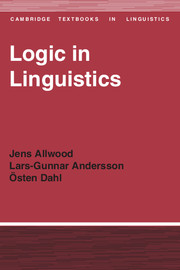Book contents
- Frontmatter
- Contents
- Preface
- Symbols and notational conventions
- 1 Logic for linguists
- 2 Set theory
- 3 Inference and logical analysis of sentences
- 4 Propositional logic
- 5 Predicate logic
- 6 Deduction
- 7 Modal logic
- 8 Intensional logic and categorial grammar
- 9 Further extensions
- 10 Logic for linguists?
- References
- Answers to exercises
- Index
1 - Logic for linguists
Published online by Cambridge University Press: 05 June 2012
- Frontmatter
- Contents
- Preface
- Symbols and notational conventions
- 1 Logic for linguists
- 2 Set theory
- 3 Inference and logical analysis of sentences
- 4 Propositional logic
- 5 Predicate logic
- 6 Deduction
- 7 Modal logic
- 8 Intensional logic and categorial grammar
- 9 Further extensions
- 10 Logic for linguists?
- References
- Answers to exercises
- Index
Summary
Most twentieth-century linguists have regarded the structural aspects of language as their main object of study. This applies not only to those linguists usually referred to as structuralists (e.g. Saussure, Hjelmslev, Bloomfield and the Prague school), but perhaps even more to Chomsky and the generative transformational school, which made important breakthroughs in the formal study of linguistic structure. But the most striking successes of structuralism have been in the fields of phonology, morphology and syntax. When it comes to the formal structure of the content or meaning of language there is much less agreed progress. Many structuralists have actually chosen to disregard the content of language, even to the point of denying that semantics is a part of linguistics.
Thus some of the most interesting attempts to characterize the structure of the content as well as structure in general are to be found not within linguistics proper but within formal logic. Although twentieth-century logic has concentrated on the logic of mathematics and mathematical language, ordinary everyday language has also been analysed, though less thoroughly, by logicians such as Frege, Russell, Carnap, Reichenbach and Montague. Linguists and logicians have now begun seriously to apply logical methods to the study of natural languages, and several very interesting analyses of semantic structure have appeared.
- Type
- Chapter
- Information
- Logic in Linguistics , pp. 1 - 2Publisher: Cambridge University PressPrint publication year: 1977



